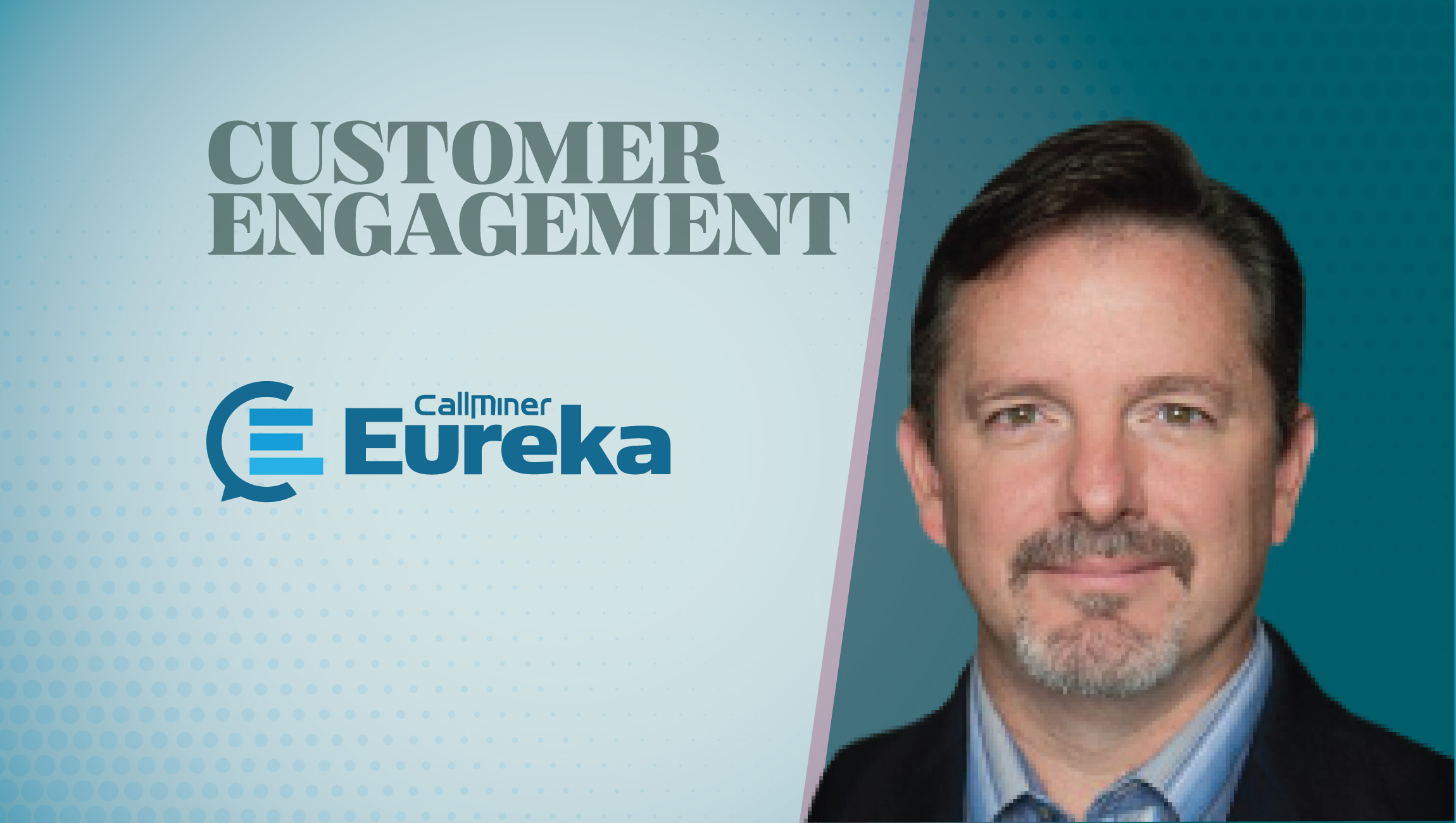Tell us about your role and the team/technology you handle at CallMiner.
As Co-Founder and CTO at CallMiner, I oversee all aspects of the team’s vision and development of our SaaS-based customer engagement and speech analytics platform and product suite, Eureka. All seven of our product solutions—Analyze, Coach, Capture, Alert, Visualize, Redact and API—work interchangeably by leveraging Artificial Intelligence (AI) and Machine Learning (ML) to analyze both ends of each customer interaction and drive customer experience (CX), regardless of the communication channel.
What runs the CallMiner data engine?
The core data processing engine that fuels our entire cloud-based customer engagement analytics platform is built using sophisticated microservices architecture. To put it simply, this allows for faster, more reliable information that supports the capacity to scale across even the largest enterprises. Our speech analytics isn’t a one-size-fits-all solution, but instead a technology that’s designed to run on an organization’s unique metadata and become more sophisticated or “smarter” with each interaction.
Do you leverage AI ML algorithms at CallMiner? If yes, tell us more about your AI research and analytics.
AI and ML are critical components of Eureka—starting with transcription, the very foundation of the platform. We use an advanced combination of deep neural networks and ML to optimize accuracy. On any given day, our platform captures and analyses over 2 million interactions and 1 billion words, whether that be from calls, chats, emails, or social media for our customers. To make sense of all that information, both in real-time and post-interaction, we leverage ML and conversational AI to categorize and tag each conversation— as well as measure acoustics including tempo, stress, agitation, silence and more—to truly understand overall conversation context. Using that data, we’re then able to generate uniquely informed insights that our customers can put into action, based on their business’s objectives.
What is the current technology driving Data Analytics for Sales and Customer Service?
In today’s increasingly data-driven world, the competitive advantage for Sales and customer service relies heavily on an organization’s ability to personalize their offerings and analyse customer trends and usage patterns. Customization optimizes loyalty and encourages new business—which is why these departments are turning to Big Data. However, not only does this require capturing and storing mass amounts of information—but also being able to quickly turn that information into action, which wouldn’t be possible without Automation and Machine Learning. These aren’t just industry buzzwords anymore, but rather necessary elements in ensuring customer satisfaction and reducing churn. By automating the engagement analysis process and integrating a technology that learns over time, Marketing and Sales teams alike can achieve a holistic view of the customer’s perception of whichever brand, product, campaign or service they choose.
What major developments have you been part of in the Speech Analytics market?
With over 17 years in the business, I’ve been a part of not only CallMiner’s continuous growth and development but also the pioneering of the industry itself. While many companies claim to “do” speech analytics, we’re the first to offer a truly customized, comprehensive and—most importantly—accurate approach. Information that used to take hours, days, and even weeks to sort through and extract value from are now accessible in minutes, thanks to speech analytics.
By eliminating random call sampling, the technology alleviates stress and has redirected the focus of quality assurance (QA) teams through transcription and agent performance automation. We’ve also helped take speech analytics from an automated call transcription tool to a sophisticated software that considers all aspects of the conversation—from the rate of speech and stress in a caller’s voice, to monitoring employee compliance and knowledge—allowing businesses to directly pinpoint areas of improvement and allowing these employees to focus on the value-add tasks that will improve the bottom line.
Using Speech Analytics, how do you differentiate between various data points- Audience, Customer, Intent, Sentiment and Big Data?
Regardless of the data point, speech analytics turns otherwise-qualifiable data into quantifiable data. By analysing not only the words, but the phrasing and acoustics, along with categorizing and scoring 100% of your interactions, we’re able to tailor our observations to suit your specific needs, starting on day one of implementation. For insight around customer sentiment, we use semantic building blocks including ownership, empathy, escalation, and more to achieve a unified view of the customer journey—or gain insight into customer attitudes toward specific products, campaigns, or other topics. For trend tracking, we automatically categorize and tag every call and make observations pertaining to customer behaviors, procedures, business outcomes, competitors, and more. We take this approach to measure virtually any key aspect of business performance.
How can marketers leverage Speech technology with Intent data and digital signals to obtain true Identity Resolution?
Understanding what is happening during 100% of Sales conversations is the key to unlocking immediate opportunities that directly impact top-line revenue. Speech analytics optimizes transparency and expedites Identity Resolution through real-time engagement analysis and consumer behavior tracking. It has a direct impact on Sale conversions and creating personalized offers that are unique to each customer – which in turn, reduces customer churn and improves survey results by automating performance from an employee standpoint and identifying preferences and frustrations from a customer’s perspective. A holistic view of historical customer data can quantify an individual’s likelihood to accept an upsell offer or threaten churn based on a previous negative encounter, while real-time analysis has the power to make suggestions to agents that create a one-of-a-kind experience that will ultimately maximize customer lifetime value through optimized brand perception.
How can an organization obtain ROI from their call centers? Will bots take over human interactions completely?
There are several ways in which contact centers influence an organization’s ROI—whether that’s through direct contribution to revenue or loss mitigation. Contact center agents are at the front lines of your CX strategy—and they’re interacting with dozens of customers each day. With customer retention costing five times less than acquisition, it pays to invest in the contact center.
Agents also play a huge role in Sales initiatives and tracking the tendencies of high performers to retrain staff and deliver a better close and conversion rate role to evidently increase revenue. From a risk management perspective, organizations can avoid fines by identifying which compliance areas are high-risk and adjusting their training programs to minimize future legislation violations.
Despite popular belief, picking up the phone is still the preferred method of contact for today’s consumers when they experience a problem. Automation means teams that would have otherwise had to listen in on calls can instead be redeployed somewhere else—such as improving employee performance based on personalized, unbiased feedback. The ultimate goal in everything that we do and what we’ll continue to work toward is to eliminate the mundane tasks that humans face every day—not the human.
What impact do these call centers have on the customer journey and experience?
One interaction can either make or break a customer’s perception of your brand, and with the cost of customer churn reaching $136 billion—the rising pace of switching should be alarming to today’s decision makers. The telephone is still the preferred customer service channel for nearly half of today’s consumers, so your agents play a pivotal role in determining your customers’ loyalty toward your brand. With that being said, most of what leads up to customer churn is for the most part avoidable—so allocating the resources necessary to deliver a positive customer experience is critical.
Tell us about your product roadmap for the next 2-3 years?
As a company that prides itself on continuous innovation, we’re always looking to what’s next. Aside from the fact that our existing platform becomes more valuable each day as its ML and AI capabilities develop alongside our customer’s data—we have some exciting news coming down the pipeline. We’ll soon be announcing new additions that will provide our customers with even faster speed to Business Intelligence.
What are your predictions about your market/customer base in the next 3 years?
CX is not only a key performance indicator within the contact center, but has become a critical factor in any enterprise strategy—and there’s no sign of that slowing down anytime soon. People outside of the call center are finally waking up to the fact that there’s a lot of value in not only uncovering the what behind their interactions, but also the why.
Over the next three years, I see us expanding our footprint outside of the contact center even more so than we already have. Regardless of the industry, the companies that invest in speech analytics are really going to take off, while those that neglect to shift their focus will undoubtedly fall victim to outdated customer feedback methods and legacy call recording systems.
Customer centricity is going to offer a competitive edge—arguably replacing marketing in terms of the impact it has on brand awareness and customer loyalty—so the more insight a company has into their voice of the customer (VoC) and voice of the employee (VoE) programs, the more successful they will be.
Jeff Gallino oversees research, language development, and future product direction. Gallino was President and CEO during CallMiner’s first five years. During that time, he led the company to become an internationally recognized and award winning enterprise software company.
Jeff has more than 25 years of experience delivering complex software and hardware solutions to enterprise and government customers. Prior to founding CallMiner, Jeff worked at companies like; ThinkEngine Networks, Grant Thornton Consulting, as well as 11 years in the United States Air Force. He holds a BS degree in Computer Science from the United States Air Force Academy.
CallMiner is a speech analytics solutions for improving agent performance. With 14 years of industry leadership and over 2 billion hours of conversations mined, they are able to deliver exceptional value to customers by delivering highly effective, usable, and scalable speech analytics solutions.
CallMiner helps businesses and organizations improve contact center performance and gather key business intelligence by automating their ability to listen to every customer interaction. Founders Gallino, LaCoursiere and Brown incubated CallMiner in 2002. Since then they’ve established a global footprint and have offices throughout the U.S. and U.K.
CallMiner strives to maintain an organizational agility that allows them to adapt to the ever-changing needs of the market. Over 300 customer requested features have been implemented into their products and their software services team brings extensive product knowledge and years of hands-on best-practice expertise to each customer engagement. CallMiner is agnostic to the source system that captures data, supporting integration with all market leading call recorder, chat, and email systems and popular social networking sites.











